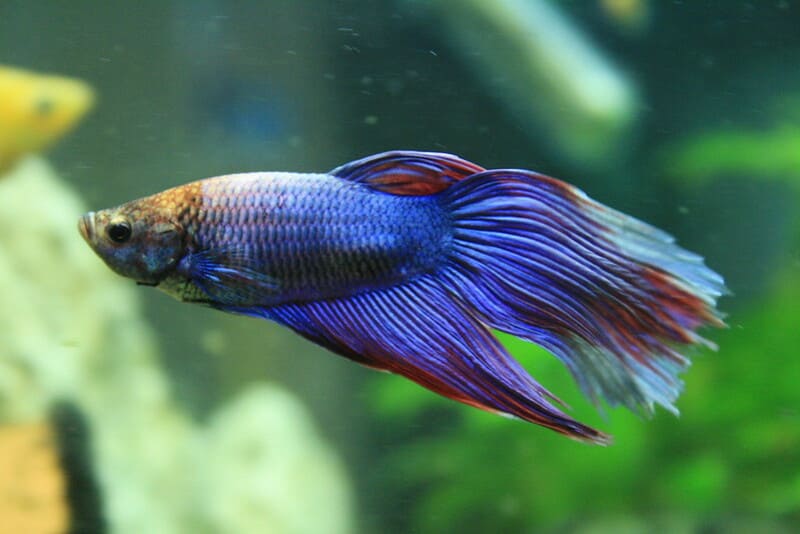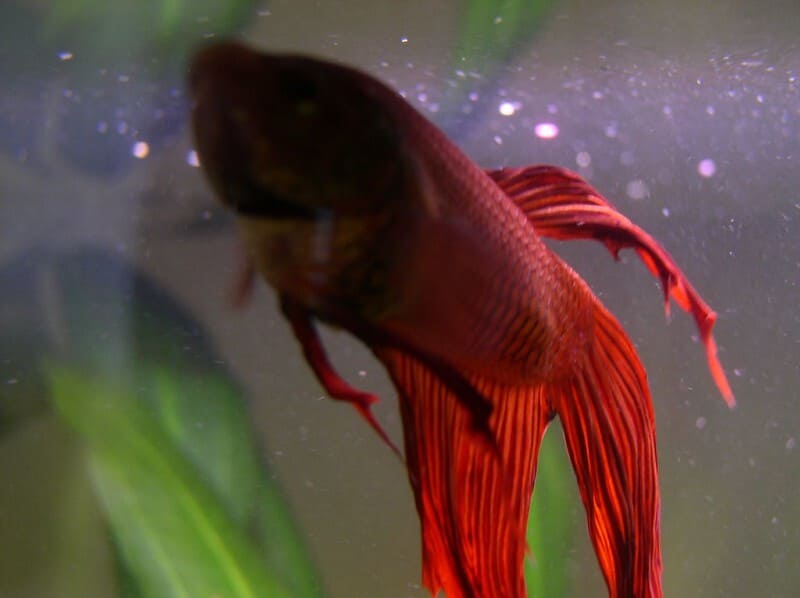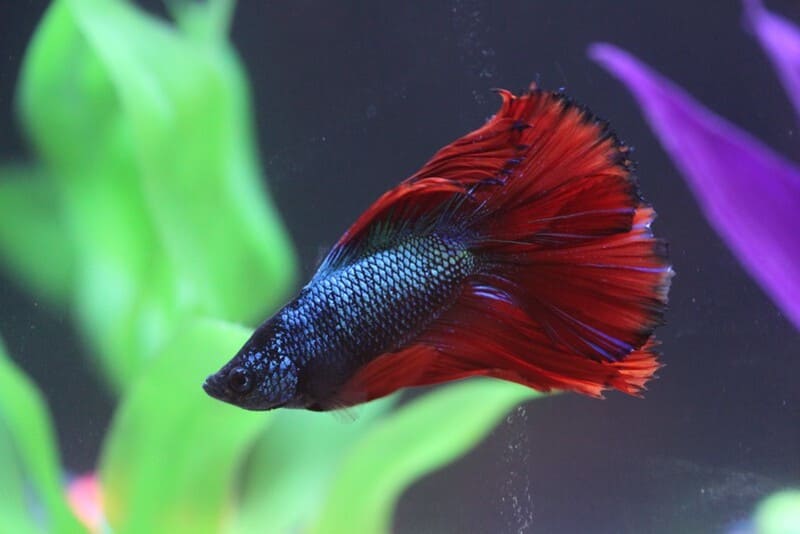Betta fish are known for their striking appearance and unique personalities, making them a favorite choice among aquarium enthusiasts. One common misconception about bettas is whether they are saltwater or freshwater fish. In this comprehensive guide, we will delve into the world of betta fish and clarify the confusion surrounding their habitat, natural environment, and water preferences.

Natural Habitat of Betta Fish
To understand the saltwater vs. freshwater debate regarding betta fish, it’s essential to explore their natural habitat and the environmental conditions they are adapted to in the wild.
Native Range
Betta fish are native to Southeast Asia, primarily inhabiting regions such as Thailand, Cambodia, Malaysia, and Vietnam. Within these areas, bettas can be found in various types of water bodies, each with its unique characteristics.
Rice Paddies and Floodplains
One of the primary habitats for bettas is rice paddies and floodplains. These areas consist of shallow, slow-moving waters, often inundated during the rainy season. Betta fish have adapted to thrive in these conditions, where water may be relatively still and enriched with organic matter.
Swamps and Marshes
Bettas are also commonly found in swamps and marshes. These habitats are characterized by heavily vegetated waters with submerged and emergent plant species. The dense aquatic vegetation provides bettas with shelter and breeding sites.
Slow-Moving Streams and Ponds
Betta fish are known to inhabit slow-moving streams and ponds in their natural range. The water in these streams and ponds is typically warm and tropical, with little to no current. The presence of vegetation, particularly floating plants, is common.
Brackish Water Environments
In some regions, bettas can be found in brackish water environments where freshwater and saltwater mix. These areas are transitional zones, and bettas have adapted to a range of salinities.
Water Parameters
To determine whether betta fish are saltwater or freshwater fish, we need to examine the typical water parameters of their natural habitats:
- pH Level: Bettas are typically found in slightly acidic to neutral waters, with a pH range of 6.5 to 7.5. These values indicate a preference for freshwater conditions.
- Hardness: Betta fish are adaptable to a range of water hardness levels, but they generally thrive in slightly soft to moderately hard water.
- Temperature: Betta fish are tropical fish and prefer warm water. Their preferred temperature range is between 78 to 80 degrees Fahrenheit (25-27 degrees Celsius). This temperature range is consistent with freshwater conditions.
- Salinity: While bettas can adapt to brackish water, their primary habitat is freshwater. In their natural range, they are more commonly associated with freshwater environments, such as rice paddies and ponds.
Are Betta Fish Saltwater?
The answer to the question of whether betta fish are saltwater is a resounding “no.” Betta fish are freshwater fish, and their natural habitats primarily consist of freshwater environments. While it is true that some species of bettas are found in brackish water habitats, the most well-known and commonly kept betta species, Betta splendens, is unequivocally a freshwater fish.
Freshwater Preferences
The most widely kept betta species, Betta splendens, exhibits a clear preference for freshwater conditions. In the aquarium hobby, Betta splendens is exclusively maintained in freshwater setups. These fish are not equipped to tolerate the higher salinity levels found in saltwater environments. In fact, exposing Betta splendens to saltwater can be harmful and potentially fatal to them.
Brackish Water Betta Species
While Betta splendens is a true freshwater fish, some other betta species have adapted to brackish water environments. Brackish water is a mix of freshwater and saltwater, with salinity levels that typically fall between those of pure freshwater and seawater. Species such as Betta mahachaiensis and Betta persephone are examples of bettas that can be found in brackish waters in their natural range. However, these species are less common in the aquarium trade, and most aquarists are more familiar with Betta splendens.
Avoiding Salt in Betta Aquariums
It is crucial to avoid adding salt or marine salt mix to your betta aquarium, as it can have detrimental effects on the health and well-being of Betta splendens. These fish have evolved to thrive in freshwater conditions, and altering the salinity of their environment can lead to osmoregulatory stress and other health problems.
In certain situations, such as when treating specific health issues, aquarium salt may be used at a recommended dosage and under the guidance of a veterinarian or an experienced aquarist. However, the routine addition of salt to a betta aquarium is unnecessary and can do more harm than good.

Brackish Water Bettas
As mentioned earlier, there are betta species that inhabit brackish water environments in their natural habitat. Let’s explore these brackish water bettas and their specific requirements.
Betta mahachaiensis
Betta mahachaiensis, also known as the Mahachai betta, is a brackish water species found in the Mahachai District of Thailand. These bettas inhabit tidal streams and can tolerate varying levels of salinity. They are adapted to the fluctuating salinity conditions in their habitat, which can change with the tides.
In captivity, Betta mahachaiensis requires a carefully maintained brackish water setup with a specific range of salinity. This species should not be kept in freshwater conditions, as it is not adapted to them. To care for Betta mahachaiensis, you need to replicate the brackish water parameters it encounters in the wild.
Betta persephone
Betta persephone is another brackish water species found in the coastal regions of Thailand and Myanmar. These bettas are adapted to environments where freshwater meets seawater. They are commonly found in tidal zones and estuaries.
In captivity, Betta persephone requires a brackish water setup with specific salinity levels to thrive. This species, like Betta mahachaiensis, should not be kept in freshwater conditions. Careful consideration of the salinity and environmental parameters is essential for their well-being.
Care of Brackish Water Bettas
If you are interested in keeping brackish water bettas, it’s essential to understand their specific care requirements. Here are some key considerations for caring for brackish water bettas:
- Salinity: Maintain the appropriate salinity level for the specific betta species you are keeping. A refractometer or hydrometer can help you measure the salinity accurately.
- Water Quality: Ensure that water quality is excellent. Regular water changes are essential, and filtration should be efficient.
- Substrate and Decor: Use a substrate and decor that replicate the natural habitat of the species. Brackish water setups may include sand or fine gravel, as well as driftwood and rocks.
- Feeding: Provide a balanced diet suitable for brackish water bettas. These fish may consume a variety of foods, including live, frozen, and prepared options.
- Tank Mates: Choose tank mates that are compatible with brackish water conditions and the specific betta species. Research the requirements and behavior of potential tank mates.
- Acclimation: When introducing brackish water bettas to your aquarium, perform a gradual acclimation process to help them adjust to the salinity and environment.
- Research: Thoroughly research the specific betta species you plan to keep to ensure you meet their unique needs.
Specialized Brackish Water Aquarium
To create a suitable habitat for brackish water bettas, consider setting up a dedicated brackish water aquarium. This aquarium should be separate from your freshwater setups to prevent cross-contamination of salinity levels.
Research the specific requirements of the betta species you intend to keep and replicate their natural environment as closely as possible. This may involve using marine salt mix to achieve the desired salinity, which is higher than freshwater but lower than full-strength seawater.
Acclimation Process
When introducing brackish water bettas to their new aquarium, follow a careful acclimation process. This helps the fish gradually adapt to the salinity and reduces the stress associated with sudden changes in water parameters.
Here’s a general guideline for acclimating brackish water bettas:
- Prepare Containers: Use containers or buckets to mix water of different salinities, such as the aquarium’s salinity and the water the fish arrived in. Label the containers accordingly.
- Float Container: Place the betta fish in a container or bag, and float it in the aquarium for about 15-20 minutes to equalize the temperature.
- Add Water Gradually: Over the course of several hours, gradually add water from the aquarium to the container with the betta. This should be done in small increments to allow the fish to adjust to the increasing salinity.
- Release the Betta: Once the salinity in the container matches that of the aquarium, release the betta into its new environment.
- Monitor Closely: Keep a close eye on the betta for the first few days to ensure it is acclimating well and displaying normal behavior.
Species-Specific Guidance
Because different betta species may have varying requirements for salinity, it is essential to research the specific needs of the species you plan to keep. Some brackish water bettas may require lower salinity levels, while others may thrive in higher salinity conditions.

Maintaining a Freshwater Betta Aquarium
For the most common betta species, Betta splendens, maintaining a freshwater aquarium is the standard and recommended practice. Here are the key considerations for creating and maintaining a freshwater betta aquarium:
1. Water Parameters
To create an ideal environment for Betta splendens, it is essential to maintain specific water parameters. These include:
- pH Level: Betta splendens prefer slightly acidic to neutral water conditions. A pH range of 6.5 to 7.5 is suitable.
- Water Hardness: Bettas are adaptable to a range of water hardness levels, but they generally thrive in slightly soft to moderately hard water.
- Temperature: Betta splendens are tropical fish and require warm water. The recommended temperature range for them is between 78 to 80 degrees Fahrenheit (25-27 degrees Celsius).
2. Tank Size
Betta splendens should be kept in an adequately sized aquarium to ensure their well-being. A minimum tank size of 5 gallons is recommended, although larger tanks, such as 10 gallons or more, provide more space for swimming and the inclusion of hiding places and decorations.
3. Filtration
Using a suitable filtration system is crucial to maintain water quality in a betta aquarium. A gentle filter with adjustable flow is ideal, as bettas do not appreciate strong water currents. An aquarium filter will help remove waste and maintain water clarity.
4. Decorations and Hiding Spots
Betta fish enjoy having access to hiding spots and decorations in their tank. Live or artificial aquatic plants, caves, and floating betta logs provide shelter and enrichment. These features also help replicate the natural habitat of bettas.
5. Feeding
A balanced and varied diet is essential for the health of Betta splendens. Feed them high-quality betta pellets or flakes, as well as live or frozen foods such as brine shrimp, bloodworms, and daphnia. Feeding should be performed in moderation to prevent overfeeding and water quality issues.
6. Tank Mates
If you wish to keep tankmates with your betta fish, choose species that are compatible with their temperament and habitat preferences. Avoid aggressive or fin-nipping fish, and ensure that the tank is appropriately sized for multiple inhabitants.
7. Water Changes
Regular water changes are vital to maintain optimal water quality. Perform partial water changes of about 25% of the tank’s volume every one to two weeks. This helps remove accumulated waste and replenishes essential nutrients.
Conclusion
Betta fish, specifically Betta splendens, are unequivocally freshwater fish. They are adapted to thrive in freshwater conditions, and their natural habitat primarily consists of freshwater environments such as rice paddies, ponds, and slow-moving streams. While there are some betta species that inhabit brackish water habitats, these species are less common in the aquarium trade.
It is crucial to provide Betta splendens with the appropriate freshwater conditions to ensure their health and well-being. Attempting to keep them in saltwater or brackish water environments can be harmful and stressful for these beloved aquarium fish. Understanding the natural habitat and water preferences of bettas is fundamental to providing them with the care and environment they need to thrive in captivity.
